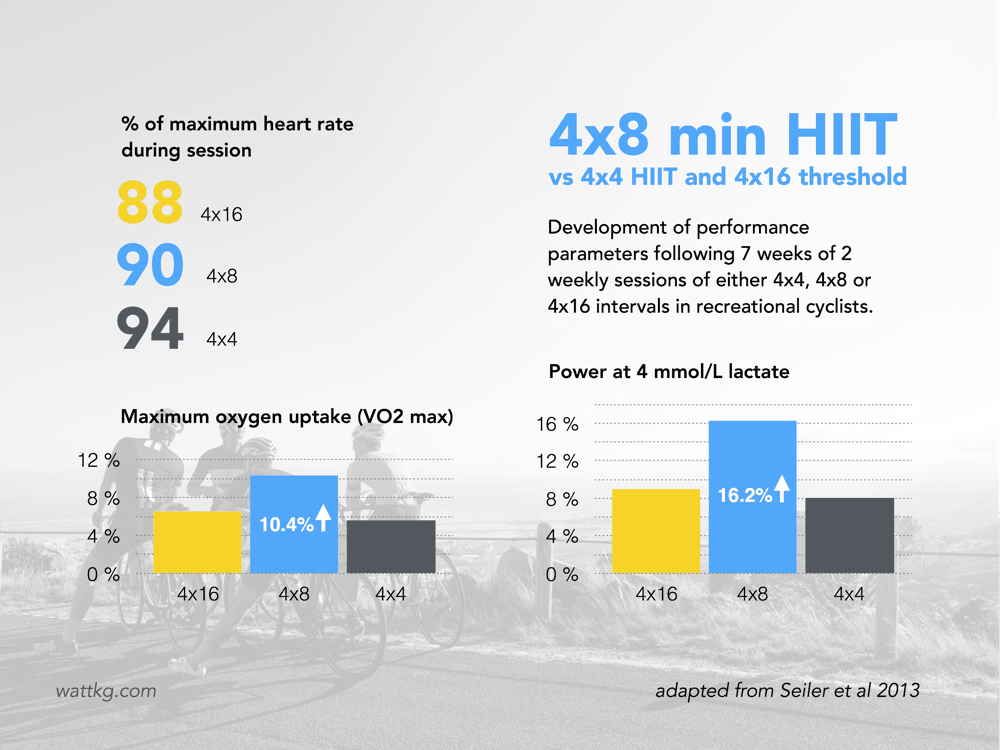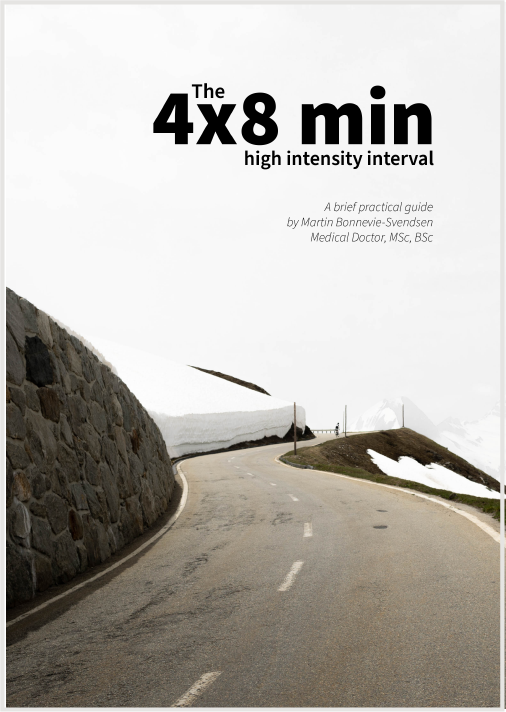Nearly all cyclists use long intervals in one form or another.
However, not all long intervals are created equal. As it turns out, if you choose the wrong length you might be giving up big performance gains.
So, how long should your intervals be?
This study by Seiler and colleagues sheds some light on the matter (1).
Adaptations to aerobic interval training: interactive effects of exercise intensity and total work duration
In a 2013 study, Seiler and colleagues compared the effects of three different formats of long intervals on 35 cyclists (1). The training period lasted for 7 weeks.
Who were the cyclists?
35 amateur cyclists (29 male, 6 female) between the age of 25 and 49 partook in the experiment. Prior to the study their weekly training volume was 4-10 hours and mean maximum oxygen consumption (VO2 max) was 52 ml/kg/min.
How did they train?
The cyclists were divided in four groups. For a 7 week training period they performed one of the following programs:
One group did continuous training at low to moderate intensity only. This consisted of 4-6 weekly sessions and the subjects were instructed to increase their weekly training volume by 20-30%.
A second group performed two weekly sessions of 4×16 min intervals, separated by 3 min recovery periods. In addition to this, 2-3 weekly workouts at low intensity was performed.
A third group undertook two weekly sessions of 4×8 min intervals with 2 min recovery periods. An additional 2-3 weekly low-intensity rides were performed.
A fourth group completed two weekly sessions of 4×4 min intervals. Again with 2 min recovery periods and an further 2-3 low-intensity rides per week.
All riders were instructed to perform intervals at “maximal effort”.
How did it go?
Before and after the training period, all riders were tested for:
- VO2 max
- Power at VO2 max
- Peak heart rate
- Power at 4 mmol/L lacate
The post-test results were as follows.

The 4×8 group displayed the greatest relative change in physiological capacity, and across all test parameters.
Power at 4 mmol/L lactate (approximate lactate threshold) improved from 241W to 280W in the 4×8 group. This correlated to a lift from 2,69 to 3,18 W/kg and an increase in threshold power of 16.2%.
By comparison, the 4×16, 4×4 and low-intensity groups displayed increases in threshold power of 9%, 8% and 8% respectively.
VO2 max improved with 10.4%, 6.5%, 5.6% and 3.4% in the 4×8, 4×16, 4×4 and low-intensity group, respectively.
The difference between the 4×8 and the other groups was statistically significant (p<0.02).
The results of this study are interesting for several reasons.
Small variables yield big differences
The three long interval formats induced slight differences in work intensity. Percent of peak heart rate was reported to reach 94%, 90% and 88% for the 4×4, 4×8 and 4×16 interval, respectively.
These differences in intensity become even more obvious when reviewing the blood lactate measurement sampled during the workouts. Average values taken after the third and fourth work period showed 13, 10 and 5 mmol/L lactate for 4×4, 4×8 and 4×16, respectively.
This tells us two things.
Firstly, lactate is a far more sensitive measure of training intensity than heart rate is. This is probably also why research articles nearly always measure intensity by blood lactate, rather than heart rate.
Secondly, this indicates that the 4×8 min allows a more beneficial combination of intensity and duration of intervals. It would be natural to assume that 32 minutes at heart rates approaching 90% of HR max induces a greater total training stimulus than 16 minutes at 94% of HR max.
In plain english:
By dropping your intensity slightly, you can allow yourself to sustain the intervals a lot longer. And thereby probably induce a greater total training stimulus per workout.
These findings also suggest there is a bottom cut-off point for when lowering the intensity and doubling the interval durations is beneficial.
The 4×16 session too involved twice the duration of the 4×8 session. However, this did not make up for the slightly lower intensity (88% vs 90% of peak heart rate, and 5 vs 10 mmol/L lactate).
It appears then, that for recreationally trained riders with two weekly interval sessions, you need to achieve an intensity slightly higher than threshold training to achieve the biggest performance gains (when comparing session to session).
Aiming for a heart rate of 90% of max appears to yield a beneficial relationship between intensity and interval duration.
How would the 4×8 long intervals stack up against the 30/15 interval?
In a previous article I discussed the exciting results concerning the 30/15 high intensity intervals. How do they compare to these 4×8 long intervals?
That is certainly an interesting question. To which I have no certain answer.
However, it is fun to speculate.
The better trained, the bigger training stimulus is required to achieve further physiological development.
In the two studies we have discussed, the riders had quite different fitness levels at baseline (mean VO2 max of 52 in Seiler et al and 66 in Rønnestad et al).
In the Rønnestad study, the 30/15 group achieved a 12% and 9% increase in threshold power and VO2 max (1). I am inclined to suggest that this represents a bigger performance gain than the 16% and 10% improvement seen in the Seiler 4×8 group.
However, the Rønnestad study used a longer training period (10 vs 7 weeks), which would allow more time for adaptation to occur. Based on these data, it’s difficult to safely say that one of the two is superior to the other.
The powerful long + short combo
Instead of choosing either or, I would suggest the 4×8 and 30/15 interval could work very well together.
Used in conjunction, these short and long interval formats will provide great “coverage” of training stimuli in both the lower and higher end of the high-intensity spectrum.
If you want to read more about how to perform the 4×8 interval, I have attached a PDF below. I also added some additional workout progressions of different durations and intensities:
Get the 4×8 HIT interval & other workout instructions in my free newsletter

When you subscribe to my newsletter you will receive the sprint-in-LIT and other workout instructions, science reviews and discussions of best training practices. There is also occasional information about my paid services. I will take care not to clutter your inbox.
Good luck with your 4×8 session!
PS! You may also experiment with using the above 4×8 sessions with fast start intervals.
Take-home message
This study demonstrates that a 4×8 minute interval format induces greater performance enhancement in a group of recreational cyclists when compared to 4×16 minute “threshold training” or 4×4 minute “VO2 max training”.
The cyclists in this study were in the lower end of the fitness scale, and the results might therefor have looked differently in more highly trained riders. Nevertheless, it appears that a working intensity of about 90% of maximum heart rate allows for a beneficial combination of sufficiently high intensity and long total duration of work.
The 4×8 minute interval therefor appears to be yet another valuable workout to consider for your high-intensity training.
References:
- Seiler S et al. Adaptations to aerobic interval training: interactive effects of exercise intensity and total work duration. Scandinavian Journal of Medicine & Science in Sports, 2013;23:74-83
- Rønnestad BR et al. Short intervals induce superior training adaptations compared with long intervals in cyclists – An effort-matched approach. Scandinavian Journal of Medicine & Science in Sports, 2015;25:143-151
